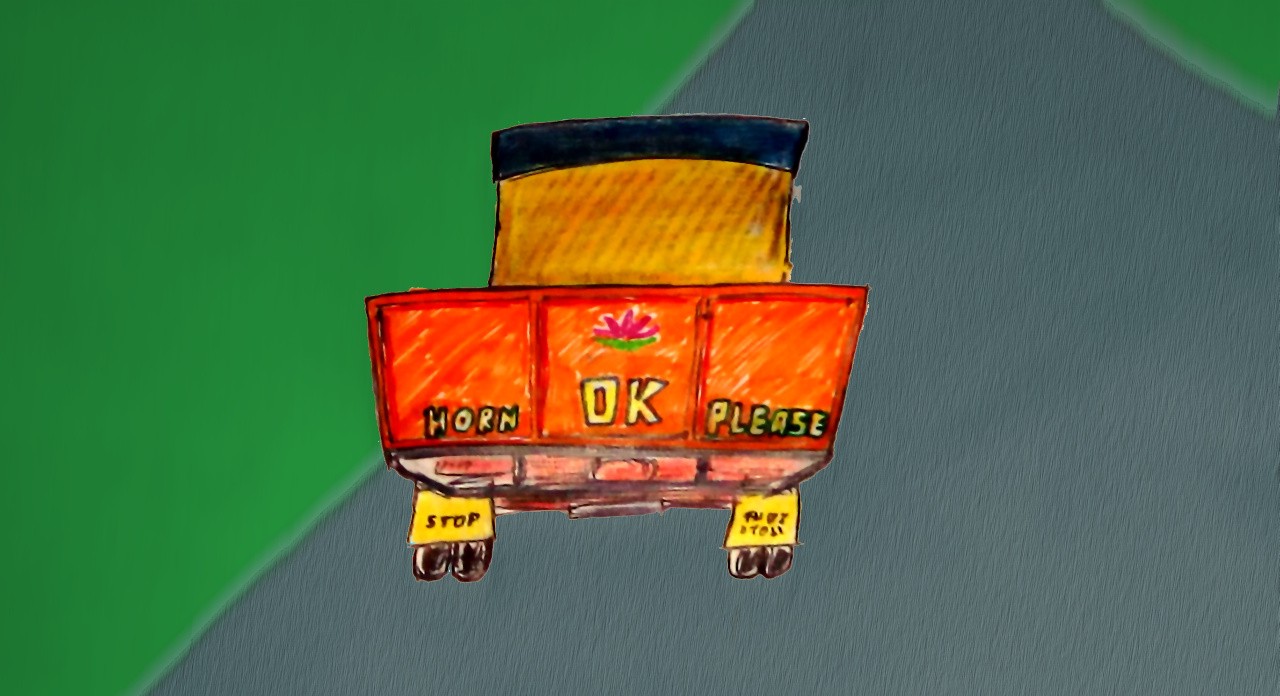Horn OK Please
It’s written on practically every Indian lorry. But what does it mean?

It’s written on practically every Indian lorry. But what does it mean?
Have you ever wondered about the meaning of “Horn OK Please” that comes on the back of so many trucks?
The reason for it is clear: it’s to remind people to horn when they come close to the truck, so the truck knows someone is behind them. It’s probably meant to make people horn before overtaking, but the sign was banned in Mumbai because it was also encouraging people to horn all the time. And there’s enough horning anyway, without encouraging them further.
But why that particular phrase? Why “Horn OK Please”, instead of just “Horn Please”? Why not “Horn Please, OK?” or “OK, Please Horn”? “OK” is normally bigger than “Horn” and “Please”, so perhaps it’s meant to be read separately.
There is actually not just one but many explanations as to how this phrase came about. The main problem is not finding an explanation, but picking out the right one.
One theory is that the “Horn Please” was there as usual, to remind people to horn. But it also happened that a lot of the lorries in India were made by Tata, and had the ‘TATA’ logo on the back. Because a lot of people say “okay, tata!” instead of “bye”, lorry-drivers used to paint “OK” above the “Tata” on their lorries. But the Tata wasn’t as visible as the OK, so people kept reading it as “Horn OK Please”.
Another possible reason is also related to Tata. Once, the Tata Oil Mills Company (TOMCO) had created this new brand of detergent called “OK”. As part of their advertising, they painted this “OK”, along with its lotus symbol, at the backs of the lorries they made. Later, people thought “OK” was also part of the message. This will also explain why so many lorries have a lotus drawn over the “OK”!
During the Second World War, fuels like diesel and petrol were getting scarce. So a lot of trucks switched to using kerosene as an alternative fuel. Now, kerosene is actually made for jet-planes, and it can catch fire much more easily than other fuels. So people driving kerosene-run trucks had to be extra-careful not to crash. Maybe they decided to warn other people too, and painted “OK” so others knew the truck was running “On Kerosene”.
Earlier, most highways in India were single-lane. So when a person was overtaking a lorry, they had to be careful of traffic coming the other way. And this was difficult, because they couldn’t see very much beyond that big trailer. So they worked out an arrangement where the lorry-driver would see the oncoming traffic, and turn on a red light to signal that it was OK to overtake. The red light was in the middle under the trailer, and “OK” was printed on top so it would be visible when the red OK signal came on.
Horn OK Please also follows the pattern people in India use while overtaking trucks. If you overtake from the left side, Horn first so I know what you’re doing! If you’re just following behind, that’s OK. And if you want to overtake from the right, Please proceed!
Another meaning you can get is “Horn OTK Please”, where “OTK” stands for “overtake”. Horn and then overtake, please! This theory suggests that the ‘T’ wasn’t so visible, so the phrase got mistaken as “Horn OK Please”.
Those were the most common explanations given by people, but there may be many others. Which is the real explanation? Is that what you’ve been wondering all through this article?
It looks like you’ll have to continue wondering.
This article was originally published in Sirius #196 21 Jun — 4 Jul 2016 “Horn OK Please”. Some information from Quora.
Have something to say? At Snipette, we encourage questions, comments, corrections and clarifications — even if they are something that can be easily Googled! Or you can simply click on the heart below, so we know you liked reading this.